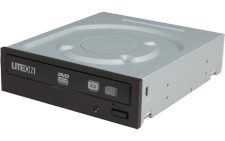DVD+RW
Stands for "Digital Versatile Disk Rewritable" and is pronounced "DVD plus RW."
DVD+RW is one of two standards for rewritable DVDs, along with DVD-RW. DVD+RW discs can be written to, erased, and rewritten up to 1,000 times and can store up to 4.7 GB of data or video. Since the rewritable surface is less reflective than write-once formats like DVD+R or commercially-pressed discs, DVD+RW discs are not as well-supported by DVD players. Only a compatible DVD+RW or Hybrid (DVD±RW) drive can write to a DVD+RW disc.
DVD+RW and DVD-RW discs are erasable and rewritable optical media formats. Once written, a disc's contents are read-only and cannot be edited; in order to change the data on a disc, it must be erased and then rewritten. This process makes the format a poor choice for storing files that need to be frequently modified. Instead, the rewritable discs are better suited for making frequent data backups.
An optical disc drive that can write discs has three lasers—a low-power laser that reads data, a medium-power laser that erases rewritable discs, and a high-power laser that burns data to a disc. A DVD+RW drive burns a series of spots onto a reflective layer of a phase change metal alloy on the underside of the disc. At first, this metal alloy exists in a crystalline form that lets light through. A high-power burning laser heats the alloy past its melting point, which then turns opaque as it cools. These opaque spots encode digital data that the reading laser in the drive reads and decodes. When it's time to erase a disc, the drive uses the medium-powered erase laser to heat the alloy layer to its crystallization point.
NOTE: DVD+RW and DVD-RW were developed as competing disc formats by two separate industry groups. Since the two are technically very similar, most rewritable optical disc drives are Hybrid (DVD±RW) drives that can write to both formats.
 Test Your Knowledge
Test Your Knowledge